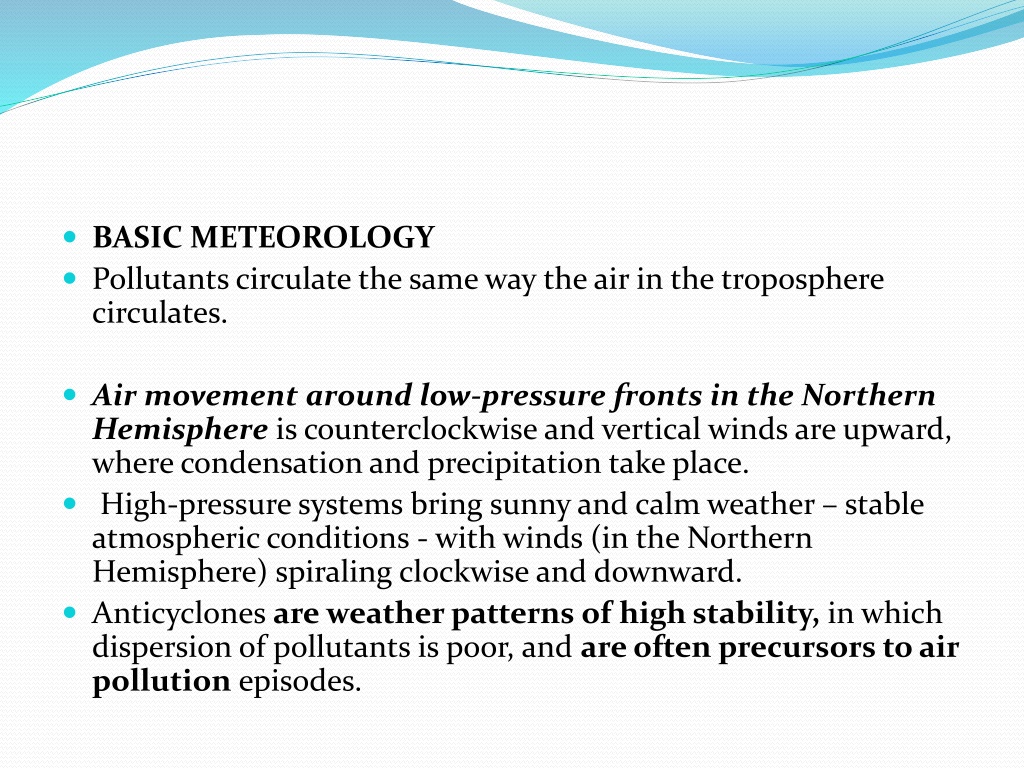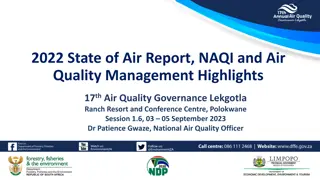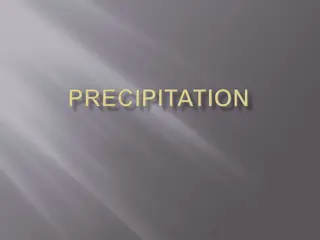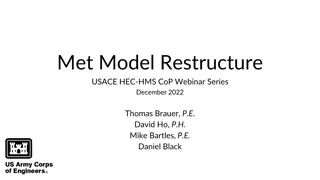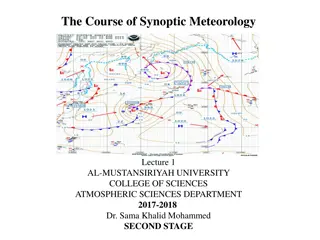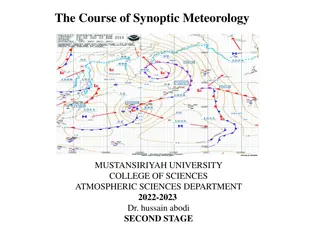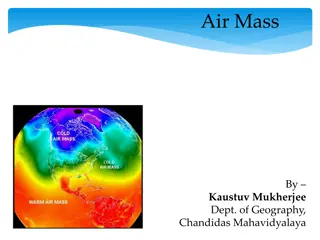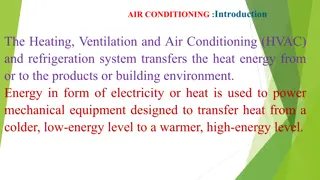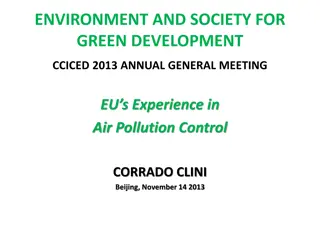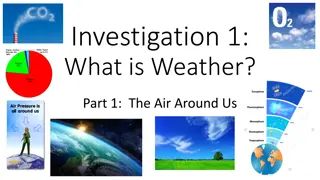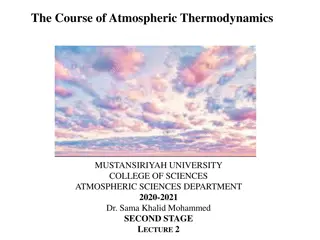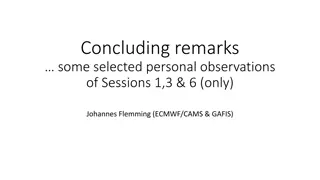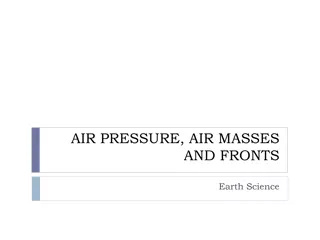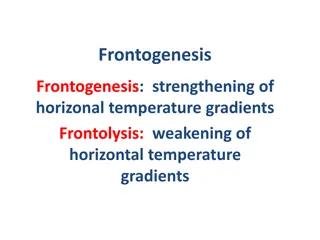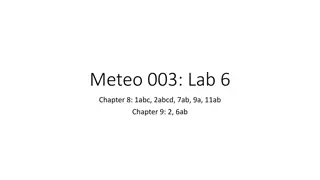Understanding Basic Meteorology Concepts for Air Quality Management
Pollutants circulate in the troposphere following air movement patterns around low-pressure fronts and high-pressure systems. Anticyclones and cyclones play a crucial role in atmospheric stability and pollutant dispersion. The relationship between lapse rates determines air stability and pollutant dispersion speed. Different stability conditions such as neutral, super-adiabatic, and sub-adiabatic impact air quality and pollutant concentrations.
Download Presentation

Please find below an Image/Link to download the presentation.
The content on the website is provided AS IS for your information and personal use only. It may not be sold, licensed, or shared on other websites without obtaining consent from the author. Download presentation by click this link. If you encounter any issues during the download, it is possible that the publisher has removed the file from their server.
E N D
Presentation Transcript
BASIC METEOROLOGY Pollutants circulate the same way the air in the troposphere circulates. Air movement around low-pressure fronts in the Northern Hemisphere is counterclockwise and vertical winds are upward, where condensation and precipitation take place. High-pressure systems bring sunny and calm weather stable atmospheric conditions - with winds (in the Northern Hemisphere) spiraling clockwise and downward. Anticyclones are weather patterns of high stability, in which dispersion of pollutants is poor, and are often precursors to air pollution episodes.
High- and low-pressure systems, are commonly called anticyclones and cyclones.
Anticyclones Are weather patterns of high stability Have poor dispersion of pollutants Are often precursors to air pollution episodes.
Vertical dispersion The rate at which dry air cools as it rises is called the dry adiabatic lapse rate dry adiabatic lapse rate is independent of the ambient air temperature. The dry adiabatic lapse rate : where T = temperature and z = altitude. The actual measured rate at which air cools as it rises is called the ambient or prevailing lapse rate.
The relationships between the ambient lapse rate and the dry adiabatic lapse rate essentially determine the stability of the air and the speed with which pollutants will disperse.
Neutral stability: when the ambient lapse rate is exactly the same as the dry adiabatic lapse rate Neutral stability conditions usually result in coning plumes
Super-adiabatic: when the air temperature drops more than 9.8oC/km Super-adiabatic atmospheric conditions are unstable and favor dispersion A looping plume also produces high ground- level concentrations
Sub-adiabatic conditions: when the air temperature drops at a rate less than 9.8oC/km. A special case of sub-adiabatic conditions is the temperature inversion, when the air temperature actually increases with altitude and a layer of warm air exists over a layer of cold air. Sub-adiabatic conditions are stable and result in poor dispersion; Inversions are extremely stable and trap pollutants, inhibiting dispersion.
Under stable (subadiabatic) conditions, the fanning plume tends to spread out in a single flat layer. Fumigation: pollutants are caught under an inversion and are mixed owing to a strong lapse rate
ATMOSPHERIC DISPERSION Dispersion is the process by which contaminants move through the air and a plume spreads over a large area, thus reducing the concentration of the pollutants it contains. The plume spreads both horizontally and vertically. The most commonly used model for the dispersion of gaseous air pollutants is the Gaussian model
Assumptions The predominant force in pollution transport is the wind; Pollutants move downwind The greatest concentration of pollutant molecules is along the plume center line. Molecules diffuse spontaneously from regions of higher concentration to regions of lower concentration The pollutant is emitted continuously, and the emission and dispersion process is steady state.
Where: C(x, y, z) is the concentration at some point in space with coordinates x, y, z in g/m3 Q = the emission rate of the pollution source (in g/s), u = the average wind speed in ( m/ s ) , y= the standard deviation of the plume in the y direction (m) z= the standard deviation of the plume in the z direction (m)
At ground level, the above equation reduces to (z=0): The greatest value of the concentration is along the plume centerline (y=0)
The standard deviations y, and z, are measures of the plume spread in the crosswind (lateral) and vertical directions, respectively. They depend on atmospheric stability and on distance from the source. Atmospheric stability is classified in stability classes/ categories A through F.
Stability classes Class A is the least stable; Class F is the most stable. Classes A, B, and C are associated with super-adiabatic conditions; Class D with neutral conditions; and Classes E and F with sub-adiabatic conditions. Class G, indicates conditions of extremely severe temperature inversion, but in considering frequency of occurrence is usually combined with Class F. Urban and suburban populated areas rarely achieve stability greater than Class D, because of the heat island effect; stability classes E and F are found in rural and unpopulated areas.
Standard deviation or dispersion coefficient, y, in the crosswind direction as a function of downwind distance
Standard deviation or dispersion coefficient, z, in the vertical direction as a function of downwind distance
Variation of Wind Speed With Elevation Wind direction shifts and wind speed varies with time and elevation. The variation of wind speed with elevation can be approximated by a parabolic wind velocity profile: The exponent n, called the stability parameter, is an empirically determined function of the atmospheric stability, and is given in T
Effective Stack Height The effective stack height is the sum of stack height and the height, above the stack to which the plume rises before dispersing downwind, h: For super-adiabatic conditions: For neutral stability:
For sub-adiabatic conditions: Where: Vs= stack gas exit speed (in m/s ) , d = stack diameter (in m), and Qh= heat emission rate from the stack (in kJ/s)
A useful formula for estimating worst case mean concentrations downwind of a point source is the following equation suggested by Hanna et al. where: Q = source strength or emission rate of gas or particulate [kg/s] Cwc= worst case concentration [ g/m3] U = worst case wind speed at height z = 10 m, usually 1 m/s Wwc= y , worst case cloud width [m] (usually assume W = 0.1x, where x is distance from the source) Hwc= z ,worst case cloud depth (usually assume H = 50 m in worst case)
